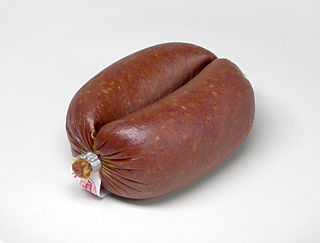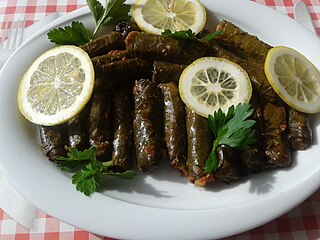
Turkish cuisine is the cuisine of Turkey and the Turkish diaspora. Although the cuisine took its current rich form after numerous cultural interactions throughout centuries, it should not be confused with other cuisines such as Ottoman cuisine or Seljuk cuisine. Turkish cuisine with traditional Turkic elements such as yogurt, ayran, kaymak, exerts and gains influences to and from Mediterranean, Balkan, Middle Eastern, Central Asian and Eastern European cuisines.

Tzatziki, also known as cacık or tarator, is a class of dip, soup, or sauce found in the cuisines of Southeastern Europe and West Asia. It is made of salted strained yogurt or diluted yogurt mixed with cucumbers, garlic, salt, olive oil, sometimes with vinegar or lemon juice, and herbs such as dill, mint, parsley and thyme. It is served as a cold appetizer (meze), a side dish, and as a sauce for souvlaki and gyros sandwiches and other foods.

Moussaka is an eggplant (aubergine)- or potato-based dish, often including ground meat, which is common in the Balkans and the Middle East, with many local and regional variations.

Sujuk or sucuk (/suːˈd͡ʒʊk/) is a dry, spicy and fermented sausage which is consumed in several Balkan, Middle Eastern and Central Asian cuisines. Sujuk mainly consists of ground meat and animal fat usually obtained from beef or lamb, but beef is mainly used in Turkey, Bosnia and Herzegovina, Albania, Armenia, Bulgaria, Kazakhstan, and Kyrgyzstan.

Huevos rancheros is a breakfast egg dish served in the style of the traditional large mid-morning fare on rural Mexican farms.

Sarma, commonly marketed in the English-speaking world as stuffed grape leaves, stuffed vine leaves, or stuffed cabbage leaves, is a food in Southeastern European and Ottoman cuisine made of vegetable leaves rolled around a filling of grains, minced meat, or both. The vegetable leaves may be cabbage, patience dock, collard, grapevine, kale or chard leaves. Sarma is part of the broader category of stuffed dishes known as dolma.

Shakshouka is a Maghrebi dish of eggs poached in a sauce of tomatoes, olive oil, peppers, onion, and garlic, commonly spiced with cumin, paprika and cayenne pepper. According to Joan Nathan, shakshouka originated in Ottoman North Africa in the mid-16th century after tomatoes were introduced to the region by Hernán Cortés as part of the Columbian exchange. Shakshouka is a popular dish throughout the Middle East and North Africa.

Poha, also known as pohe, aval, pauwa, sira, chira, chivda, or avalakki, among many other names, is flattened rice originating from the Indian subcontinent. Rice is parboiled before flattening so that it can be consumed with very little to no cooking. These flakes of rice swell when added to liquid, whether hot or cold, as they absorb water, milk or any other liquids. The thickness of the flakes varies from almost translucently thin to nearly four times thinner than a normal rice grain.

Stuffed peppers is a dish common in many cuisines. It consists of hollowed or halved bell peppers filled with any of a variety of fillings, often including meat, vegetables, cheese, rice, or sauce. The dish is usually assembled by filling the cavities of the peppers and then cooking.

Israeli cuisine primarily comprises dishes brought from the Jewish diaspora, and has more recently been defined by the development of a notable fusion cuisine characterized by the mixing of Jewish cuisine and Arab cuisine. It also blends together the culinary traditions of the various diaspora groups, namely those of Middle Eastern Jews with roots in Southwest Asia and North Africa, Sephardi Jews from Iberia, and Ashkenazi Jews from Central and Eastern Europe.

Kesme or erişte is a type of egg noodle found in various Central Asian countries. It is also found in Turkish cuisine and is called erişte and “kesme” in modern standard Turkish. The word itself is a nominalisation of the verb to cut or to slice, referring to the slicing of the dough involved in preparing the noodles. The term may refer to the noodles themselves, or the prepared dish made with them. Kesme is traditionally a homemade dish, and not often found at restaurants or cafés. In Turkey, kesme is also known as "erişte", and eaten generally in winter. It is made from flour, egg, water, salt and milk. These ingredients are worked into a dough, which is rolled out, cut, and dried in the sun or an oven after dried for a day.

A meatball is ground meat (mince) rolled into a ball, sometimes along with other ingredients, such as bread crumbs, minced onion, eggs, butter, and seasoning. Meatballs are cooked by frying, baking, steaming, or braising in sauce. There are many types of meatballs using different types of meats and spices. The term is sometimes extended to meatless versions based on vegetables or fish; the latter are also commonly known as fish balls.

Şakşuka is a Turkish side dish or meze made of vegetables cooked in olive oil. The particular vegetable may vary from region to region, but eggplant is a common choice. In Balıkesir şakşuka is made with green tomatoes. The dish sometimes includes potato and peppers as well.

Strapatsada is a popular dish in many regions of Greece, especially the Ionian Islands, due to the availability and low cost of its ingredients. It is often prepared "on the spot" and served for lunch or a light snack; however, it can also be served cold. The dish is also known as kagianas, koskosela or menemeni.
Soğan kebabı is a Turkish kebab dish made with ground lamb kofte baked inside sliced onions, peppers and pomegranate sauce.

Kuzu haşlama is a Turkish dish of bone-in lamb that is boiled with vegetables like onions, potatoes and carrots. Some variations include zucchini, celery root, or chickpeas.
Saniye Anne Yemekleri is the YouTube channel of Saniye Karataş, which has over 570,000 subscribers. The videos for her channel are filmed by her son Süleyman Karataş. Karataş, who lives in Izmir, Turkey, turned 77 in 2018. She insists that a proper menemen is made with onions.

Kuzu şiş is a Turkish lamb kebab made with the thigh of the lamb, and served with onion and tomato garnishes.

Şevketibostan yemeği is a dish cooked and consumed in Aegean region of Turkiye. Ingredients include Şevketibostan, lamb chunks, onion, juice of half a lemon, flour, butter, and salt.

















